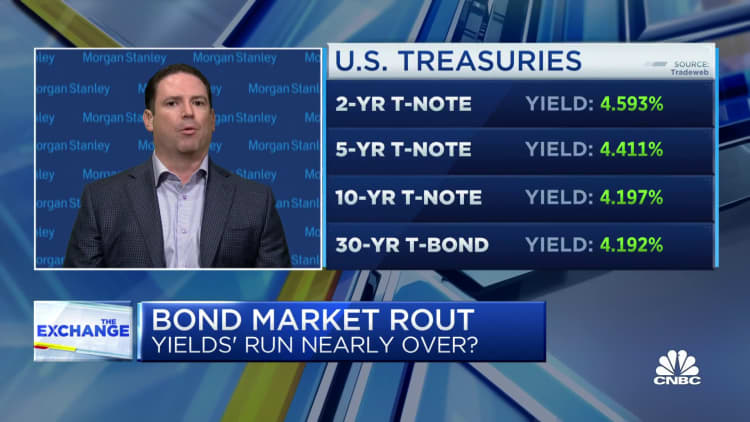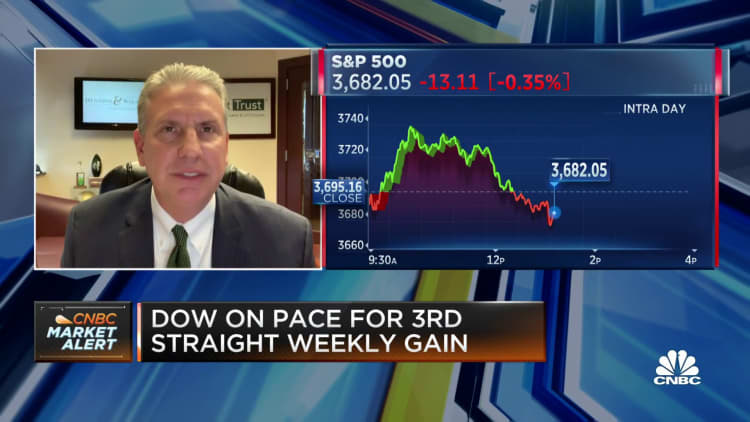Employees work at the BMW manufacturing plant in Greer, South Carolina, October 19, 2022.
Bob Strong | Reuters
The economy sent a low-key signal Thursday that a recession is looming — and that the Federal Reserve could be making a policy mistake by continuing to try to slow things down.
According to the Conference Board’s Leading Economic Indicators index, conditions worsened in September, with the gauge down 0.4% from the month before and off 2.8% for the six-month period.
“The US LEI fell again in September and its persistent downward trajectory in recent months suggests a recession is increasingly likely before year end,” said Ataman Ozyildirim, senior director of economics at the Conference Board. Ozyildrim noted that the weakness in the index was “widespread” as high inflation, a decelerating jobs picture and tighter credit conditions are pressuring the economy.

The index looks forward using 10 metrics that include manufacturing hours worked, jobless claims, building permits, stock market indexes and credit spreads.
Normally, the LEI is not considered a major data point. It’s not necessarily that the measure isn’t a good snapshot of the economy, but more that the data points that go into the index are already known, so there’s not much new information.
A reverse trend for the Fed
However, in the present conditions, the index is of greater significance as it comes at a time when the Federal Reserve is looking to tighten the screws further on growth in an effort to bring down rampant inflation.
That bucks a general historical trend where the Fed is usually loosening policy when the outlook turns darker. However, Fed officials are stressing that they’re far from finished when it comes to raising rates.
“We went from a Fed that was way too easy to being irresponsibly tight,” said Joseph LaVorgna, chief U.S. economist at SMBC Capital Markets and a former senior economic advisor to then-President Donald Trump. “When this basket is signaling the weakness that it’s showing, what the Fed typically does is not raise rates. But in this case, it’s not only raising rates aggressively, but with a commitment to continue raising rates aggressively.”
LaVorgna’s research shows that in previous downturns in the leading indicators, the Fed was always cutting rates or in pause at the same time. This was the case in early 2020, the financial crisis in 2008 and the recession in the early part of the 21st century — among multiple other economic contractions.
He is concerned that the Fed’s insistence on tightening policy will have even worse outcomes ahead.
“The lags in the policy mean the full effects of Fed actions have not yet been wholly felt. Worryingly, the Fed is not done,” LaVorgna said in a client note.
LaVorgna is not alone in his belief that the Fed is overdoing its efforts to tamp down inflation that continues to run around its highest levels since the early 1980s.
In a recent CNBC interview, Starwood Capital Group CEO Barry Sternlicht said the central bank is risking “unbelievable calamities if they keep up their action, and not just here, all over the globe.” Goldman Sachs CEO David Solomon, JPMorgan Chase CEO Jamie Dimon and Amazon founder Jeff Bezos in recent days all have expressed concern about a recession ahead, though they have not singled out the Fed’s actions.
Disappointment on inflation
However, Philadelphia Fed President Patrick Harker said Thursday he thinks the central bank still has work to do before it can relax as he said he’s seen a “disappointing lack of progress” in the inflation fight.
“What we really need to see is a sustained decline in a number of inflation indicators before we let up on tightening monetary policy,” said the central bank official, who is a nonvoting member of the rating-setting Federal Open Market Committee.
Thus far, the inflation data indeed has not been on the Fed’s side.
In addition to the typical headline metrics such as the consumer price index and the Fed’s preferred personal consumption expenditures price index, the Cleveland Fed’s “sticky price” CPI rose 8.5% on an annualized basis in September, up from 7.7% in August. The measure looks at items such as rent, the price of food away from home and recreation costs.
Services inflation has been particularly nagging, rising 7.4% in September on a 12-month basis, up from 6.8% in August, according to Trading Economics. That has happened as the economy has transitioned back to services from high goods demand for much of the Covid era.

Critics, though, say the Fed is following too many backward-looking data points. But policymakers also are fighting a battle against inflation expectations that, while drifting lower now, could turn higher especially now that gasoline prices are rising again.
“The challenge for the Fed is we haven’t seen the true leading indicators be leading in the sense that inflation has still stayed persistently elevated in the face of these leading indicators that would suggest otherwise,” said Jeffrey Roach, chief economist for LPL Financial.
In Roach’s view, the only bright spot is that financial markets could be close to pricing in all of the damage from higher rates and inflation. Also, the continued decline in the LEI at least could give the Fed reason to slow the pace of its rate hikes. Roach expects the Fed to hike by another 0.75 percentage point in November, then decelerate to a 0.5-point move in December, which is not the market expectation.
“In a nutshell, this report does not likely change anything for the November meeting,” Roach said. “However, you could argue that this does build a case for a downshift in December.”
Source: https://www.cnbc.com/2022/10/20/an-often-overlooked-economic-measure-is-signaling-serious-trouble-ahead.html
